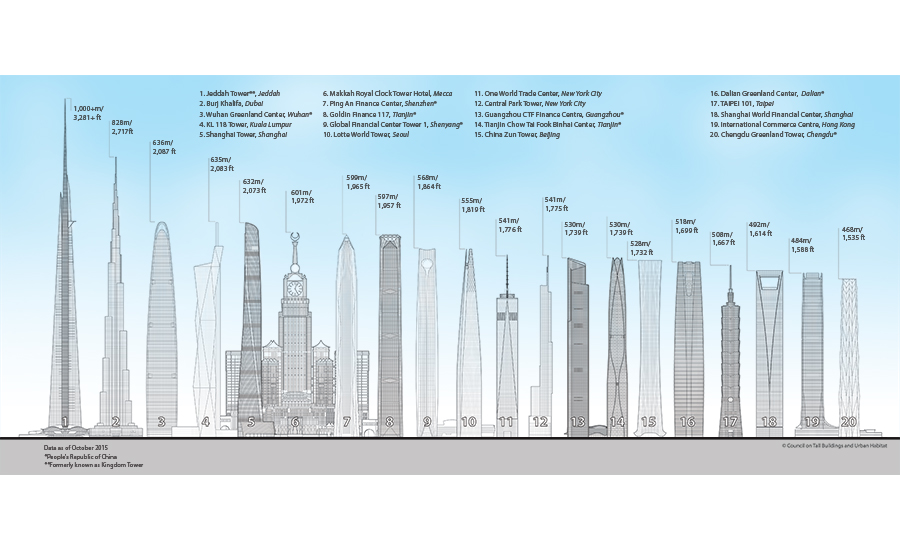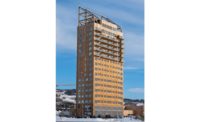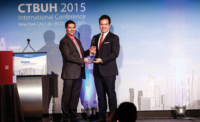In a stunning comeback from near-collapse at the turn of the millennium, the Council on Tall Buildings and Urban Habitat is flourishing. Membership increased 672% from 2004 through 2014. There are 39 CTBUH chapters and committees across six continents. And the group’s activities are unprecedented.
A recent push involves drawing in not just the designers, contractors and suppliers that build the skyscrapers but also the clients that finance them. “We are involving more owners and developers in our dialogue,” said David I. Malott, a principal of architect Kohn Pedersen Fox Associates PC and CTBUH’s chairman, at the CTBUH’s 14th Annual Best Tall Building Symposium, held on Nov. 12 at the group’s headquarters, the Illinois Institute of Technology (IIT), Chicago.
Further, a big shift toward architecture has taken place since 2006, soon after the 2001-05 CTBUH chairman, Ron Klemencic, moved the 46-year-old group to IIT from Lehigh University and recruited Antony Wood as executive director (ENR 11/6/06 p. 10). “We were rooted in structural engineering, which is still a huge part, but if you look at our members, they encompass every aspect of tall buildings,” said Wood.
Klemencic, chairman and CEO of structural engineer Magnusson Klemencic Associates, is credited with reviving the group after the mid-1990s retirement of CTBUH’s founder, the late Lynn Beedle. And Wood, who spends 80% of his time on the council and 20% teaching architecture at IIT, is credited with re-establishing the group as the global authority on tall buildings.
CTBUH has 595 individual members, but its 449 member organizations allow it to reach out to 823,919 professionals around the world in 6,162 different offices, according to the group.
This year, there have been nearly 100 chapter events around the world, including the 2015 CTBUH international conference, held Oct. 26-28 in New York City. That conference, which focused on developers and the flow of capital across cities, drew 1,200 registrants from 45 nations.
For those who hungered for more technical content at the conference, the group published a 700-page volume, “Global Interchanges: Resurgence of the Skyscraper City,” which contains contributed papers on structural engineering, facades, fire and life safety, vertical transport and technological advances. In addition, the group published a 187-page research report, “Life Cycle Assessment of Tall Building Structural Systems.”
The report, authored by Dario Trabucco, Antony Wood, Olivieri Vassart, Nicoleta Popa and Donald Davies and funded by $300,000 from steel company ArcelorMittal, is considered the first in-depth look into life-cycle assessment of tall structures and a first attempt to environmentally quantify the effectiveness of the design and engineering of skyscrapers. The authors considered two impact categories: global warming potential and embodied energy.
Other recent CTBUH technical publications include ASHRAE’s “Design Guide for Tall, Supertall, and Megatall Building Systems and Vertical Greenery: Evaluating the High-Rise Vegetation of the Bosco Verticale, Milan,” authored by Elena Giacomello and Massimo Valagussa and sponsored by a $20,000 grant from Arup. The report examines the 10,142 sq ft of greenery on the walls and balconies of two high-rises.
A report on megacolumns is due out in April, and a publication on tall-building damping is expected out next fall. Future research subjects may include adaptive reuse of tall buildings, skybridges as a means of egress in fire, a tall-building curtain-wall rating system and a report on tall timber buildings. All publications are available for sale through ctbuh.org.
Expansion

|
| Malott |
In March, CTBUH opened an office in Shanghai—its third after Chicago and its research office in Venice. Six years ago, the group did not have a single member in China. “Now, China is the second-biggest membership base after the U.S.,” said Wood. “Though the market in China is slowing down, it is still the biggest market in tall buildings.”
The group also has three new formal affiliates, including New York, the U.K. and India. Malott reports that CTBUH Korea is close to becoming a formal chapter, and he is spearheading one in Japan.
Malott has more on his agenda than adding affiliates. He is encouraging more diversity in the group and starting with CTBUH New York, where he is a co-director. “My personal goal is to make the council a more diverse place,” he said. “There is a lack of female representation” within the group, which reflects the demographics of the construction industry, he added.

|
| Wood |
To try to get more women involved, CTBUH New York is organizing an event, planned for March, in conjunction with the American Institute of Architects’ Women in Architecture group, “to give voice to very deserving female leaders” by having them present their work and talk about their experience as women in a traditionally male-dominated field, said Ilkay Can-Standard, an architectural designer at KPF and the co-chair of CTBUH New York’s Young Professionals Committee.
Like Can-Standard, many CTBUH members volunteer their time to organize events and develop publications. But to keep the machine—and the website—going, Wood has built up the staff.
In 2006, CTBUH had two employees. Currently, the group has 28 full-time- equivalent job slots in its three offices and an annual operating budget of $3.5 million.
CTBUH’s biggest fund-raiser is the yearly international conference, which supports “operations for the other 51 weeks,” said Wood. For example, he added, no one pays the group for website development, which includes the interactive Skyscraper Center, a database rich with information on all things related to tall buildings.
“We sell our books, but everything we do is open source,” said Wood. “We are doing a lot more” than in years past.






Post a comment to this article
Report Abusive Comment